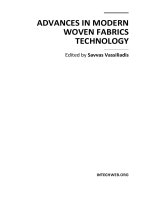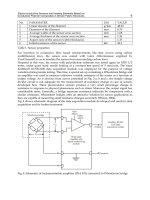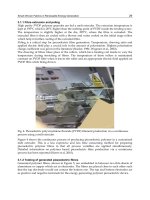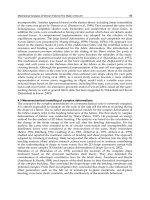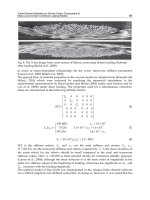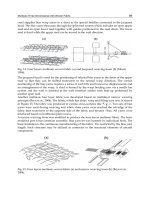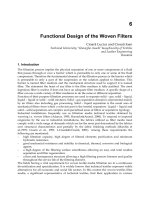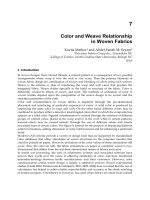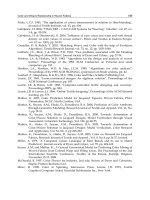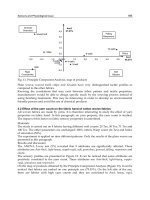Advances in Modern Woven Fabrics Technology Part 3 doc
Bạn đang xem bản rút gọn của tài liệu. Xem và tải ngay bản đầy đủ của tài liệu tại đây (1.87 MB, 20 trang )
Smart Woven Fabrics in Renewable Energy Generation
29
3.1.1 Fibre extrusion and poling
High purity PVDF polymer granules are fed a melt extruder. The extrusion temperature is
kept at 195°C which is 20°C higher than the melting point of PVDF inside the feeding screw.
The temperature is slightly higher at the die, 205°C, where the fibre is extruded. The
extruded fibre is then air cooled with a blower and water cooled on the initial stage rollers
which help in further cooling of the extruded fibre.
Poling is a critical step for piezoelectric fibre generation. Temperature, drawing ratio and
applied electric field play a crucial role in the amount of polarisation. Highest polarisation
charge coefficient was given in the literature (Sessler, 1981; Wegener et al., 2002).
The drawing of fibres takes place at the rollers, which have heating coil inside to vary the
temperature during stretching of fibres. The temperature of these rollers is maintained
constant on PVDF fibre when it leaves the roller and an appropriate electric field applied on
PVDF fibre while being drawn.
Fig. 4. Piezoelectric polyvinylidene fluoride (PVDF) filament production via a continuous
process using a melt extruder
Figure 4 shows the continuous process of producing piezoelectric polymer in a customised
melt extruder. This is a less expensive and less time consuming method for preparing
piezoelectric polymer fibres in that all process variables are applied simultaneously.
Detailed information on polymer based piezoelectric fibre production via a continuous
process has been reported (Siores et al, 2010).
3.1.2 Testing of generated piezoelectric fibres
Generated polymer fibres, shown in Figure 5, are embedded in between two thin sheets of
aluminium or copper which act as electrodes. The fibres are placed close to each other such
that the top electrode would not contact the bottom one. The top and bottom electrodes act
as positive and negative terminals for the energy generating polymer piezoelectric device.
Advances in Modern Woven Fabrics Technology
30
Poled PVDF fibres generate about 5 V
oc
when a moderate mechanical stimulus is applied on
to the fibres. The obvious advantage of producing flexible piezoelectric fibres is to be able to
produce large area active surfaces by incorporating piezoelectric fibres in wearable
technologies. However, to generate enough electricity for wearable applications to power
small electronic devices, produced flexible piezoelectric fibres need to be used in a fabric
structure such as woven, knitted, nonwoven and 3D structures.
Fig. 5. Polymer based flexible piezoelectric fibre generated by a continuous process using the
melt extruder.
4. Smart woven fabrics
Each fabric making method has its own special attributes which help us to find most
applicable fabric structure and method for a specific application. By weaving polymer based
piezoelectric fibres into woven fabrics, smart piezoelectric fabrics can be produced and used
for many responsive applications.
Weaving is one of the best fabric making techniques that can be used for smart fabric
production. Warp threads can be located at the heddles with different orders and wefts are
travelled through warps by shuttle(s). The position of heddles designates where wefts will
be going over or under the warps.
While a fabric is being designed, expectations from the final fabric are taken into
consideration. For smart piezoelectric fabrics, depending on expected energy generation
from the final product, weaving designs can be variable. In this case, intersection of
piezoelectric (the charge generator) and conductive (the charge carrier) fibres is crucial. One
piezoelectric fibre can interlace more than one conductive fibre. One conductive fibre can
also interlace more than one piezoelectric fibre. However, one conductive fibre can only
interlace the same pole of the each piezoelectric fibre.
A number of weaving designs are studied below for smart woven fabrics. Conductive fibres
and conventional (non-conductive) fibres are needed alongside piezoelectric fibres. Because
piezoelectric fibres carry negative charges on one side along its length and positive charge
on the other side, a conductive material is needed to carry the charge produced by
Smart Woven Fabrics in Renewable Energy Generation
31
movements of the piezoelectric fibres. Conductive wires would add extra rigidity to the
fabric which is an undesirable outcome for most textile structures.
The best alternative to undesirable wires may be conductive fibres are produced and
patented (Perera & Mauretti, 2009). It is claimed (Mauretti & Perera, 2010) that conductive
filaments are flexible, non-toxic and conformable for wearable applications. Electrical
conductivity of metallised synthetic (acrylic) conductive textile yarns is widely studied
(Vassiliadis et al., 2004, 2009, 2010). Mechanical and electrical properties of metallised
conductive yarn are controlled by blending conventional and conductive fibres in the yarn
and changing the ratio of fibres in the blend. The way piezoelectric, conductive and
conventional fibres are integrated into fabric structure by weaving technique, gives a good
indication of the performance of resultant fabric. When more piezoelectric fibres are used in
the fabric, this results in higher energy generation by movement and mechanical strain.
However, to be able to carry as much charge as it is possible, the right number of conductive
fibres need to interlace with piezoelectric fibres.
The possible woven fabric designs for energy generation for wearable textiles are shown in
this chapter. Blue lines represent piezoelectric fibres while red lines represent conductive
and grey lines show non-conductive conventional fibres. This is the simplest weaving
pattern produced by plain weaving technique. However, by integrating piezoelectric and
conductive fibres into this basic structure, the resultant woven fabric becomes a smart fabric
which can harvest energy from the natural sources.
Fig. 6. (a) Smart woven fabric design 1 consisting of piezoelectric, conductive and non-
conductive conventional fibres, (b) Face of the woven fabric consisting of piezoelectric,
conductive and non-conductive fibres
Polymer based piezoelectric fibres can be used as either weft or warp into the woven
structure and conductive fibres can be used as negative and positive electrodes for charge
transfer so that the resultant fabric can produce energy for micro powered electronics.
Advances in Modern Woven Fabrics Technology
32
The main advantage of the use of polymer based piezoelectric material in this application is
its flexibility and the fact that it can easily be incorporated in the woven structures without
causing any problem. It is impossible to integrate existing ceramic based piezoelectric fibres
into similar structures because these fibres are rigid and brittle thus can cause major
problems in the weaving process. For the first design shown in Figure 6(a), 2 heddles are
needed to locate conductive and non-conductive fibres/yarns and 2 shuttles, the one with
piezoelectric fibres/yarn and the other with non-conductive conventional fibres/yarn. In the
warp direction, 2 conventional fibres are located between conductive fibres. Conductive fibres
act as negative and positive electrodes.
If a number is given to each warp from left to right, odd numbered warps are located on the
first heddle and even numbered warps are located on the second heddle. During the
shuttles’ travel along the loom’s width, according to design, while the first conductive fibre
only interlaces with negative pole of piezoelectric wefts, second conductive warp interlaces
only positive pole of the piezoelectric filling fibres/yarns. Thus, any short circuit is avoided.
Figure 6(b) shows interlace of warp and weft threads and possible appearance on face of the
fabric. If the used fibres counts are the same and the warps and wefts are located with an
exact sequence, the resultant fabric will contain 24% piezoelectric, 16% conductive and 60%
non-conductive conventional fibres/yarns.
Fig. 7. (a) Smart woven fabric design 2 consisting of piezoelectric, conductive and non-
conductive conventional fibres, (b) Face of the woven fabric consisting of piezoelectric,
conductive and non-conductive fibres
The design shown in Figure 7(a) needs 2 heddles to locate conductive and non-conductive
fibres/yarns and 2 shuttles, the one with piezoelectric fibres/yarn and the other with non-
conductive conventional fibres/yarn. If a number is given to each warp from left to right,
odd numbered warps are located on the first heddle and even numbered warps are located
on the second heddle.
Smart Woven Fabrics in Renewable Energy Generation
33
During the shuttles travel along the loom’s width according to the design, the first heddle is
kept in place, second heddle is uplifted so that warps are kept apart and shuttle travels
through easily. Shuttle carrying piezoelectric fibre travels twice and then the other shuttle
which carries non-conductive conventional fibres/yarn travels once. The whole process is
repeated until the desired fabric structure is created. Thus, the first conductive warp only
interlaces with negative charged sides of piezoelectric wefts, second conductive warp
interlaces only with the positive charged sides of the piezoelectric filling fibres/yarns.
Figure 7(b) shows interlace of warp and weft threads and possible appearance on face of the
fabric. If the used fibres counts are the same and the warps and wefts are located with an
exact sequence, the resulted fabric will contain 34% piezoelectric, 18% conductive and 48%
non-conductive conventional fibres/yarns.
Fig. 8. (a) Smart woven fabric design 3 consisting of piezoelectric, conductive and non-
conductive conventional fibres, (b) Face of the woven fabric consisting of piezoelectric,
conductive and non-conductive fibres
The design shown in figure 8(a) needs 2 heddles to locate conductive and non-conductive
fibres/yarns and 2 shuttles, the one with piezoelectric fibres/yarn and the other with non-
conductive conventional fibres/yarn. If we give a number to each warp from left to right, 1
st
,
2
nd
, 7
th
, 8
th
, 13
th
, 14
th
, 19
th
, 20
th
and 25
th
warps are located on the first heddle and other warps
are located on the second heddle.
According to design in figure 8(a), while first heddle is kept in place, second heddle is
uplifted so that warps can be kept apart from the first heddle’s warps and shuttle, which
carries piezoelectric fibres/yarn, can easily travel through. The shuttle which carries
piezoelectric fibre travels twice and then the first heddle is uplifted while the second heddle
Advances in Modern Woven Fabrics Technology
34
is lowered so that the other shuttle which carries non-conductive conventional fibres/yarn
travels once through the warps. The same movements are carried out with the same order
again and again until a fabric structure is created. Thus, all the conductive warps on the first
heddle only interlace with negative pole of piezoelectric wefts and all the conductive warps
on the second heddle interlace only with positive pole of the piezoelectric wefts.
Figure 8(b) shows interlace of warp and weft threads and possible appearance on face of the
fabric. If the used fibres’ counts are the same and the warps and wefts are located with an
exact sequence, the resultant fabric will contain 34% piezoelectric, 34% conductive and 32%
non-conductive conventional fibres/yarns.
Fig. 9. (a) Smart woven fabric design 4 consisting of piezoelectric, conductive and non-
conductive conventional fibres, (b) Face of the woven fabric consisting of piezoelectric,
conductive and non-conductive fibres
The design shown in Figure 9(a) needs 2 heddles to locate conductive and non-conductive
fibres/yarns and 2 shuttles, the one with piezoelectric fibres/yarn and the other with non-
conductive conventional fibres/yarn. If we give a number to each warp, 1
st
, 2
nd
, 5
th
, 6
th
, 9
th
,
10
th
, 13
th
, 14
th
, 17
th
, 18
th
, 21
st
, 22
nd
and 25
th
warps are located on the first heddle and others
are located on the second heddle.
During the first shuttle’s travel along the loom width, the first heddle is kept in place and
the second heddle is uplifted so that warps can be kept apart from the first heddle’s warps
and shuttle which carries piezoelectric fibres/yarn can easily travel through. The shuttle
carrying piezoelectric fibre travels twice and then the first heddle is uplifted while the
second heddle is lowered so that the other shuttle which carries non-conductive
conventional fibres/yarn travels twice through the warps. The same movements are carried
out in the same order again and again until a fabric structure is created. Thus, all the
Smart Woven Fabrics in Renewable Energy Generation
35
conductive warps on the first heddle only interlace with negative pole of piezoelectric wefts
and all the conductive warps on the second heddle interlace only with positive pole of the
piezoelectric wefts.
Figure 9(b) shows interlace of warp and weft threads and possible appearance on face of the
fabric. If the used fibres counts are the same and the warps and wefts are located with an
exact sequence, the resultant fabric will contain 26% piezoelectric, 18% conductive and 56%
non-conductive conventional fibres/yarns.
5. Conclusions
Polymer based piezoelectric fibres can be used as either weft or warp into the woven
structure and conductive fibres can be used as negative and positive electrodes for charge
transfer, therefore the resultant fabric can produce energy to power small electronic devices.
The advantage of polymer based piezoelectric fibre is their flexibility so that they can easily
be used in woven structures. It is impossible to integrate existing ceramic based piezoelectric
fibres into a similar structure since they are brittle.
For all four fabric designs studied in this chapter, interlace of piezoelectric and conductive
fibre/yarn is significant. In a woven fabric structure, one piezoelectric fibre can interlace
with more than one conductive fibre and one conductive fibre can also interlace with more
than one piezoelectric fibre. However, to avoid any short circuit, one conductive fibre can
only interlace with the same pole of the each piezoelectric fibre.
Since the fibres are considered having the same thickness, in the first design, piezoelectric
and conductive fibres interlace 96 times in the fabric. The times of interlace of piezoelectric
and conductive fibres are 153 for the second design whilst it is 289 and 117 times for the
third and forth fabric designs, respectively. Therefore, the highest energy generation is
expected from the third design when they all designs are subjected to the same amount of
mechanical stimulus.
Smart piezoelectric woven fabrics can be used where they can be subjected to mechanical
strain/stress or vibrations. Depending on the application and energy need, smart
piezoelectric woven fabrics can be used to produce whole textile structure or only a part of
it. For instance, tents, awnings and umbrellas can be wholly made of smart piezoelectric
fabrics and produce electricity under rain as well as wind. However, waterproof finishing is
needed if the fabric will be used for outdoor applications.
Energy generated by piezoelectric materials is always in the form of AC, therefore a small
rectifier is needed for the conversion of the generated energy (AC) into usable energy (DC)
for low power electronics.
The best weaving technique for smart piezoelectric fabric is plain weaving and its
derivatives. Possible smart woven fabric designs are not limited. Depending on energy
need, different fabric designs can be made with less or more interlacing. Other existing
fabric making methods (other than weaving) such as embroidery can also be used to
produce smart fabrics.
6. References
Anton, S.R. & Sodano, H.A. (2007). Smart Mater. Struct., V.16, R1-R7.
Baker, J.; Roundy, S. & Wright, P. (2005). Proc. 3
rd
Int. Energy Conversion Engineering Conf.,
pp. 959-970.
Advances in Modern Woven Fabrics Technology
36
Baz, A.; Poh, S. (1988). Performance of an active control system with piezoelectric
actuators, J. Sound and Vibration, V.126, No.2, pp. 327-343.
Broudy, Eric. (1979). The Book of Looms: A History of the Handloom from Ancient Times to the
Present, University Press of New England, ISBN 0-87451-649-8, New York,
USA
De-Qing, Z. (2008). Chinese Physics Letters, V.25, p. 4410.
Dunn, P. E. & Carr, S. H. (1988). Piezoelectricity in nylon 5,7, IEEE Proceedings 6th
International Symposium on Electrets, DOI 10.1109/ISE.1988.38559
Gioello, D.A. (1982). Understanding Fabrics from Fiber to Finished Cloth, Fairchild
Publications, ISBN 87005-377-9, New York, USA
Granstrom, J.; Feenstra, J.; Sodano, H.A. & Farinholt, K. (2007). Energy harvesting from a
backpack instrumented with piezoelectric shoulder straps, Smart Materials
Structures, V.16, pp. 1810-1820.
Harrison, J. S.; Ounaies, Z. (2001). Piezoelectric Polymers, NASA/CR-2001-211422, ICASE
Report No. 2001-43
Hellwege, K.H. & Hellwege A.M. (Eds.) (1996). Ferroelectrics and Related Substances: Oxides,
Landolt Bornstein New Series, Springer, Berlin.
Holstein, P.; Leister, N.; Weber, U.; Geschke, D. & Binder, H. (1999). A Combined Study of
Polarization Effects in PVDF, 10
th
International Symposium on Electret. IEEE
Jaffe, B.; Cook, W.R. & Jaffe, H. (1971). Piezoelectric Ceramics, Academic Press,
London.
Jain, A.; Kumar, J.S.; Mahapatra, D.R. & Kumar, H.H. (2010). Proceedings of SPIE – The
International Society for Optical Engineering 7647.
Jordan, T.L. & Ounaies, Z. (2001). NASA ICASE Report No. 2001-28.
Kawai, H. (1969). The piezoelectricity of poly(vinylidene fluoride), Jpn. Journal of Applied
Physics, V.8, pp. 975-976
Mateu, L.; Moll, F. (2005). J. Intell. Mater Syst. Struct., V.16, pp. 835-845.
Mauretti, G. J. & Perera, W. R. (2010). iCon Conductive Filaments, Proceeding of Textile
Institute Centenary Conference, Manchester, UK, November 3-4, 2010
Neagu, E. R.; Hornsby, J. S. & Das-Gupta D. K. (1999). Analysis of Polarization ans Space
Charge in Thermally Poled PVDF, 10
th
International Symposium on Electrets, IEEE,
pp. 87-90
Newman, B. A.; Chen, P.; Pae, K. D. & Scheinbeim, J. I. (1980). Piezoelectricty in Nylon 11,
Journal of Apllied Physics, V.51, No.10, pp.5161-5164, DOI 10.1063/1.327283
Parvanova, V.D. & Nadoliisky, M.M. (2005). Polarization Processes in PZT Ceramics, Bulg.
J. Phys., V.32, pp. 45-50.
Perera, W. R. & Mauretti, G. J. (2009). Microwires, Methods for Their Production, and Products
Made Using Them, US Patent Number 20090260848 A1
Ramadass, Y.K. & Chandrakasan, A.P. (2010). An Efficient Piezoelectric Energy
Harvesting Interface Circuit Using a Bias-Flip Rectifier and Shared Inductor,
IEEE Journal of Solid-State Circuits, V.45, No.1, pp. 189-204.
Ramos, M. M. D.; Correia, H. M. G. & Lanceros-Mendez, S. (2005). Atomistic modelling of
processes involved in poling of PVDF, Computational Materials Science, V.33, pp.
230
Smart Woven Fabrics in Renewable Energy Generation
37
Roundy, S.; Wright, P.K.; & Rabaey, J. (2003). Computer Communications, V.26, pp. 1131-
1144.
Schmidt, V.H.; Lediaev, L. & Polasik, J. (2006). Piezoelectric Actuators Employing PVDF
Coated with Flexible PEDOT-PSS Polymer Electrodes, IEEE Transactions on
Dielectrics and Electrical Insilation, V.13, No.5, pp. 1140-1148.
Schwartz, M. (2002). Encyclopaedia of Smart Materials Vol.1-2, pp. 780-792.
Sencadas, V.; Moreira, V.M.; Lanceros-Mendez, S.; Pouzada, A.S. & Gregorio Jr. R. (2006).
α-to-β Transformation on PVDF Films Obtained by Uniaxial Stretch, Materials
ScienceForum 514-516, pp. 872-876
Sencadas, V.; Filho, R.G. & Lanceros-Mendez, S. (2006). J. Non Cryst. Solids V.352,
pp. 2226
Seo, J.W.; Ryoo, K.S. & Lee, H.S. (1985). Characteristics of Charge Traps and Poling
Behaviour of Poly(Vinylidene Fluoride), Bulletin of Korean Chemical Society, V.6,
No.4, pp. 218-221.
Sessler, G.M. (1981). Piezoelectricity In Polyvinylidene fluoride, J. Acoust. Soc. Am., V.70,
pp. 1596-1608.
Shirane, G. & Suzuki, K. (1952). Crystal structure of Pb(Zr-Ti)O
3
, J. Phys. Soc. Jpn., V.7.
Shu, Y.C. & Lien, I.C. (2006). Analysis of Power Output for Piezoelectric Energy
Harvesting Systems, Smart Materials Structures, V.15, pp. 1499-1512.
Siores, E.; Hadimani, R. L. & Vatansever, D. (2010). Piezoelectric Polymer Element &
Production Method & Apparatus Therefor. GB Patent Application Number
1015399.7
Sirohi, J. & Chopra, I. (2000). Fundamental Understanding of Piezoelectric Strain Sensors,
J. Intelligent Mater. Systems and Struc., V.11, pp. 246-257.
Sodano, H. A.; Inman, D. J. & Park, G. (2004). Shock Vib. Digest, V.36, pp.197-205.
Sodano, H.A. & Inman, D.J. (2004). A Review of Power Harvesting from Vibration Using
Piezoelectric Materials, The Shock and Vibration Digest, V.36, No.3, pp. 197-205.
Swallow, L. M.; Luo, J. K.; Siores, E.; Patel, I. & Dodds, D. (2008). Smart Mater. Struct.,
V.17
Tzou, H.S. & Tseng, C.I. (1990). Distributed piezoelectric sensor/actuator design for
dynamic measurement/control of distributed parameter systems: A piezoelectric
finite element approach, J. Sound and Vibration, V.138, pp. 17-34.
Umeda, M.; Nakamura, K.; Ueha, S. (1997). Jpn. Journal of Applied Phys., V.36, pp.3146-
3151.
Vassiliadis, S; Provatidis, Ch.; Prekas, K. & Rangoussi, M. (2004). Electrically Conductive
Spun Yarns, Proc. of the Xth International Izmir Textile and Apparel Symposium,
pp.37-49, Izmir, Turkey
Vassiliadis, S.; Rangoussi, M.; Meimaris, D.; Prekas, K. & Provaditis Ch. (2009).
Electrically Conductive Spun Yarns and their Contact Behaviour, Proceedings of
the International Conference on Intelligent Textiles and Mass Customisation,
Casablanca, Morocco
Vassiliadis, S.; Prekas, K.; Rangoussi, M.; Absalon, K. & Maillard, J. (2010). The
Conductive Spun Yarns as Electrical Components, Proceedings of the XIIth
International Izmir Textile and Apparel Symposium, pp.333-338, Izmir, Turkey
Advances in Modern Woven Fabrics Technology
38
Wegener, M.; Künstler, W.; Richter, K. & Gerhard-Multhaupt, R. (2002). Ferroelectric
polarization in stretched piezo- and pyroelectric poly(vinylidene fluoride-
hexafluoropropylene) copolymer films, J. Appl. Phys., V.92, pp.7442-7447.
Wikipedia, online access from (Jan.
2011)
Part 2
Computational Modelling
and Structural Woven Fabrics
3
Mechanical Analysis of Woven Fabrics:
The State of the Art
Savvas Vassiliadis
1
, Argyro Kallivretaki
1
,
Dimitra Domvoglou
1
and Christofer Provatidis
2
1
Department of Electronics, Technological Education Institute of Piraeus,
2
School of Mechanical Engineerin, National Technical University of Athens,
Greece
1. Introduction
The automation and integration of processes in the textile industry is dictated by the
increasing need to offer specialized products at optimum quality and low cost, satisfying at
the same time the fast cycles of fashion trends or in the case of technical applications the
delivery of products of high qualiy and of exact properties. Under these premises, computer
engineering tools, such as computer-aided engineering (CAE) and computer-aided design
(CAD), have recently gained attention. The revolutionary role of CAE and CAD tools in the
textile industry is the guaranty that the final product meets the set specifications, optimizing
thus the quality control procedure. Moreover, the prediction of the properties and the
aesthetic features of the product before the actual fabrication can essentially benefit the
textile research community [Hu and Teng, 1996]. Especially nowadays that textile materials
can be used for the production of a wide range of technical products, such as reinforcements
in composites for aerospace or marine applications or textiles for medical applications, the
prediction of the end-product’s mechanical properties is of major importance. Furthermore,
the textile raw materials are processed under low-stress conditions and it is thus reasonable
to assume that the knowledge of the possible modifications introduced via the
manufacturing process is necessary for the final product realization (Hu, 2004).
Textiles are flexible, anisotropic, inhomogeneous, porous materials with distinct visco-
elastic properties. These unique characteristics makes textile structures to behave essentially
different compared with other engineering materials. Moreover, textiles are characterized by
an increased structural complexity. Their properties mainly depend on a complicated
combination of their structural units and their interactions. The complicated nature of the
textiles’ mechanics makes them ideal candidates for a mechanical analysis using computer-
based methods.
This paper focuses on the investigation of the modeling attempts of woven fabrics. The
woven fabrics’ weave patterns as well as the deformation mechanisms of their consistent
yarns make these structures modelling extremely challenging (Parsons et al., 2010). An
extended literature review of the computational models for the deformation of woven
fabrics is presented. Based on these models, the difficulties towards a comprehensive model
for textile structures are highlighted. Taking into account the existent literature, the
perspective of developing a widely accepted integrated CAE environment for textiles
(Hearle, 2006), is also extensively discussed.
Advances in Modern Woven Fabrics Technology
42
2. Textile structures and their mechanical behavior
Since this study focuses on the investigation of the existent woven fabrics’ simulation
techniques, some introductory remarks concerning the basic structural units of these unique
substrates, are thought to be extremely useful. Textile fabrics are made of interlaced yarns
which consist of the basic element of every textile product, the fibres. Fabrics are classified
according to their manufacture process as knitted, woven and non-woven.
The computational representation of textiles is hindered by the geometrical complexity of
the textiles’ basic structural units (fibres and yarns) as well as of the fabrics’ weaving and
knitting patents. The aforementioned characteristics of the textiles woven fabrics result in
complicated deformations even in cases of simple loading. For example, the tensile
deformation of a spun yarn corresponds to the superposition of bending, tensile and
compression of the constituent helically arranged fibres. Furthermore, contact phenomena,
as sticking and sliding interaction, should be also taken into account in the mechanical
deformation analysis increasing thus further the complexity of the mechanical study.
Fabric mechanics study often leads to the introduction of models with simplifying
assumptions. The yarn, which is usually assumed as a homogeneous material, is considered
as the basic structural unit of the fabrics. The elastic properties of the homogeneous yarn
result from the elastic properties of the fibres and include the non-linear structural synergy
of them within the yarn body. Even if the yarns are assumed as homogeneous materials, the
contact phenomena dominate the deformation procedure of the fabrics. Actually, the friction
effects support the stability of the textile structures. The contact phenomena have also a
great significance for the stress and strain distribution in a fabric subjected to deformation.
The friction energy losses appear during the load transferring along threads. Thus, very
often, uneven load distribution appears within the textile structures.
Due to the large deflection effects and the nonlinearity of the textile structures’ deformation
phenomena, the fabrics mechanics study requires special attention. The relative large
deformation of the fabrics arises from the flexibility of the textile fibres and yarns as well as
from the structural details and the way of the load application. The yarns present high
deformability which results from the low values of packing factor (the ratio of the fibres
volume to the total volume of the yarn). The air trapped between the fibres is easily
removed during the axial loading imposing the reduction of the apparent yarn cross
sections and thus the high deformation of the yarns which is obviously transferred to the
fabrics. Moreover the pattern of the fabrics itself and especially the structure of the fabrics,
supports the development of high deformations. From the structural point of view the fabric
pattern can be considered as a multi-body system of yarns. The tensile deformation of the
fabric corresponds to the synthesis of two processes, the bent yarns’ straightening and their
subsequent elongation. The first process dominates in the lower loading stage and the
second process appears upon the increase of the load. Thus the load-deflection curves of a
textile structure subjected to tensile deformation is strongly nonlinear. The nonlinearity is
also supported from the change of the contact status between the yarns, the large deflection
effects observed even within the unit cell of the fabric and finally the material nonlinearities
2.1 Technical applications of textiles
Although conventional textiles are primarily used for clothing, the use of a variety of raw
materials as well as the development of new manufacturing processes led to a considerable
expansion of their possible applications. The importance of aesthetic and decorative
Mechanical Analysis of Woven Fabrics:The State of the Art
43
characteristics of textiles has been decreased by the new materials’ performance and
functionality. The growing recognition of the textiles potentials led to revolutionary new
technical applications which according to Techtextiles (the international Trade exhibition for
technical textiles) are (Horrocks, 2000):
Agrotech: agricultural (nonwoven for wind protection)
Buildtech: building and construction (awning, concrete reinforcements)
Clothtech: clothing (garments)
Hometech: household (curtains, wall covering)
Indutech: industrial applications textiles (filters)
Medtech: medical (bandages, sutures)
Mobitech: mobility (ropes, seat covers)
Oekotech: eco-friendly textiles (recyclable composites)
Packteck: packaging (nets, wrappings)
Protech: protection (bullet-proof jackets, uniforms)
Sportech: sports and leisure (carbon-fibre composites for racquet frames)
Geotech: geotextiles (nonwovens for drainage, reinforcement)
Over the last decades there is also an intensive need for high-tech materials with “life
functions”. Consequently, research interest has been moved towards the development of
textile-based structures which change their properties in response to an external stimulus,
offering products with increased functionalities. The so called ''intelligent'', ''smart'' textiles
in conjunction with the wearable electronics usually consisting of electronic modules
incorporated into textiles, support activities in military, telemedicine or rehabilitation (Rossi
et al. 2006; Tang, 2007; Cho et al., 2009). Textiles' flexibility, indicative of the wearer's
comfort, makes them ideal candidates for interfaces in contact with the human skin. Based
on these assumptions, a large number of wearable electronic systems have been developed
(Dunne et al., 2005; Xu et al., 2008; Tognetti et al., 2006). Smart textiles development requires
the synergistic action of different disciplines such as textile science and engineering, natural
sciences, material science, mechanical engineering, electrical and computer engineering and
informatics, making this promising research area extremely challenging. Furthermore, the
attention attracted by this dynamic sector of textile research is thought to make a
contribution towards a cost effective commercialization of innovative textile-based products
aiming in the improvement of people’s quality of life.
(a) (b) (c)
Fig. 1. Technical applications of textiles (a) Fabric for solar protection used in the Paul Klee
museum, (soltis-textiles, 2011), (b) DuPont’s Kevlar® XP™ developed for hard armor
applications, (DuPont, 2011), (c) Space suit developed by ILD Dover (ilddover, 2011)
Advances in Modern Woven Fabrics Technology
44
(a) (b) (c)
Fig. 2. Smart textiles (a) Interactive Led dance shoe by Moritz Waldemeyer (waldemeyer,
2011) (b) Luminate textiles by Phillips (smarteconomy, 2006), (c) Led Dress by Cute Circuit
(crunchwear, 2010)
3. Mechanical modelling of the textile structures
3.1 Classification of the modelling approaches
During the last decades, several methods were adopted for the mechanical modelling and
analysis of the textile structures. A basic classification, according to the modelling method
used, divides them into the analytical and numerical or computational approaches. The
dominant engineering design culture played important role for the development and the
succession of these approaches. Classical modelling methods find in textiles an attractive
application field. Another essential classification of the modelling of the textile structures is
made according to the scale of the model. There is micromechanical, mesomechanical and
the macromechanical modelling. The micromechanical modelling stage focuses on the study
of the yarns, tows even fabrics taking into account the structure, orientation and mechanical
properties of the constituent fibres. The mesomechanical modelling, on the other side,
studies the mechanical characteristics of the fabric unit cell considering the yarns as
homogenous structures. Finally the macromechanical modelling stage is reffered to the
prediction of mechanical performance of the fabric in complex deformations, as drape,
studing the fabric as a continuum material.
Although the mentioned modelling stages were developed as distinct analysis approaches,
their integration in a compound modelling approach was directly rised. Thus the textile
society implemented a modelling hierarchy (Takano et al., 1999; Lomov et al. 2004;
Bogdanovich, 2006) based on three modelling scales: the micromechanical modelling of
yarns, the mesomechanical modelling of the fabric unit cell and the macromechanical
modelling of the fabric sheet (Figure 3).
According to the integrated textile modelling concept, the only inputs in the total design
procedure are the fibre properties, the yarn structure and the fabric structure. In the first
modelling stage, the fibre properties and the yarn structure (yarn type, number of fibres,
orientation) are introduced as input parameters for the mechanical analysis of the yarn and
the calculation of the yarn properties. Then the yarn properties are transferred in the second
Mechanical Analysis of Woven Fabrics:The State of the Art
45
modelling stage. The selection of the required yarn properties and their attribution in the
modelled yarns corresponds to a homogenization procedure that connects the two
individual stages. Moreover the woven fabric structure is introduced in the mesomechanical
modelling stage. At the current stage the yarns are represented as continuum structures and
the analysis is limited on the study of the fabric unit cell. Then a second homogenization
stage is required for the connection of the second and the third modelling stage, defining the
required properties of the unit cell and their attribution in the continuum fabric models.
Finally the macromechanical modelling stage based on the generation of simplified
structure (usually continuum material) predicts the mechanical performance of of extended
fabric pieces in complex deformations. Each individual modelling procedure such as their
interface presents significant obstacles.
Fig. 3. Integrated textile modelling.
3.2 Classification of the deformations
The substantial difficulty arising in textile mechanics consists in the calculation of the
superposed deformations in the microscopic scale. Even a simple deformation of the woven
fabric, for example a tensile deformation, incures a complex deformation mechanism of
straightening, tensile, compression and sliding of yarns in the mesoscopic scale and
respective deformations of fibres in the microscopic scale. Moreover the percentage of the
deformation increases when it is referred to the microscopic scale since the subjected
structures are smaller. For example, a 5 % shear deformation of a fabric could impose a huge
displacement of the constituent fibres. Thus a simple deformation in the macroscopic scale
corresponds to complex deformations in the microscopic scale. However the classification of
the deformations is based on the macroscopic level. Thus the tensile, shear, bending and
compression of the fabric sheet are considered simple deformations. The complex
deformation of fabrics is mainly referred to the drape test. The performance of a fabric in
drape is very interesting for the aesthetic effects and the dynamic functionality. The fabrics
have the ability to undergo large, recoverable draping deformations by bending in single
and double curvature providing a sense of fullness and a graceful appearance. Especially
when the fabrics are used as reinforcement materials for the construction of composites,
drape is very important since it determines the formability of the fabric in the matrix. The
Advances in Modern Woven Fabrics Technology
46
drapeability of the fabric reinforcement offers the advantage of bending around double-
curvature mould producing complex shaped composite parts.
4. Analytical modeling
The first mechanical modelling and analysis attempts of the textile structures started about a
hundred years ago. The earliest publication probably is from R. Haas in the report of the
National Advisor Committee for Aeronautics in 1918 (Haas, 1918). It is worth to mention
that NACA is the early form of the today’s NASA of the US. This publication is the
translation from the German of the original article dated back on 1913 appeared in a
German Journal. The work of Haas is of great importance. Although it is the first known, it
is characterized by its integrated character. It brings together the theoretical and practical
aspects up to the testing and application topics. However the work of Haas remained
unknown for a long perod while the work of Peirce (Peirce, 1937) was considered as the
starting reference for the analytical mechanical modelling of the textile structures. The
researchers focused on the application of the existent analytical methods already used in
other sectors of engineering. The main characteristic is the balance between the
simplifications introduced and the precision of the modelling. The energy methods and the
elastica theory are dominating in these attempts.
4.1 Micromechanical modelling of simple deformations
In the field of the analytical modelling of the textile yarns, several investigations focused on
multi-filament twisted yarns. Purpose of these investigations was the prediction of the
response of a twisted yarn when subjected to a certain deformation. It was supposed that
the mechanical parameters such as the load-elongation curve of the constituent fibres, the
twist density, the initial specific volume etc are given. The analysis focused on the
correlation of the macroscopic distortion of the yarn with the microscopic response of the
constituent fibres. A basic challenge in the modelling of the yarns is the balance between the
realistic formulation and the idealization required for a theoretically treatable model. In the
most cases the yarn was considered as being made of continuous filaments of circular cross-
sections and constant linear density along their length. All the fibres were assumed to have
identical properties and to be perfectly elastic. The cylindrical-helix model of Hearle et al.
(Hearle et al., 1959), the conical-helix model of Önder and Başer (Önder & Bacer, 1996) and
the statistical model of Komori (Komori, 2001) approached the yarn mechanical modelling
from different points of view, depending on the considered alignment of the fibres. The
tensile, bending and torsional behaviour of the yarns were approached using the force, the
stress-analysis and the energy methods (Backer, 1952; Platt et al., 1959; Freeston & Schoppee,
1975; Choi & Tandon, 2006; Park & Oh, 2006).
4.2 Mesomechanical modelling of simple deformations
Starting point for the analytical modelling of woven fabrics was the uniaxial/biaxial
deformation of the plain woven structure. The proposed approaches were based on three
principal underlying geometrical models of plain weave (Dastoor et al., 1994). The “flexible
thread” model of Peirce (Peirce, 1937) assumed the yarns infinitely flexible, incompressible
and inextensible, without bending rigidity and having circular cross-sections (Figure 4,
Figure 5). The analytical transcendental equations proposed by Peirce for the systematic
Mechanical Analysis of Woven Fabrics:The State of the Art
47
description of his model cannot easily give a solution. Thus graphical and nomographic
tools were presented in order to support the users. Peirce’s model has been modified later
towards a better representation of the real fabric structure. Thus the assumptions of the race-
track (Figure 6) or elliptical (Figure 7) yarn cross-sections (Kemp, 1958; Olofsson, 1964b)
were adopted for the fabric modelling. The concept of the elastica model (Peirce, 1937), in
continue, introduced the yarn bending rigidity in the analysis. According to this model the
shape of yarn axis can be obtained by treating the yarns as elastic slender rods subjected to
transverse point forces, equidistant but alternating in direction. In general, the mentioned
models and their later modifications used the equilibrium, energy or elastica method for the
mechanical analysis.
Fig. 4. Plain woven geometry proposed by Peirce.
Fig. 5. 3D representation of woven model proposed by Peirce.
Advances in Modern Woven Fabrics Technology
48
Fig. 6. 3D representation of woven model proposed by Kemp.
Fig. 7. 3D representation of elliptic model proposed by Olofsson.
An approach including the effect of crimp and yarn extension, based on a flexible thread
model was proposed by Freeston et al. (Freeston et al., 1967). The yarns were assumed as
homogenous, linear elastic materials with linear work-hardening. An elastica model
declining from the assumption of the standard shape yarn cross-section was published by
Olofsson (Olofsson, 1964a). The shape of the cross-section of the yarns was considered as a
function of the forces acting on them and the degree of set. The mathematical analysis was
given on equilibrium conditions, on stress-strain relationships in extension and compression
and on energy in bending. The effect of fabric set was included, also, in the work of
Grosberg and Kedia (Grosberg & Kedia, 1966; Grosberg, 1966). They adopted an energy
method on small deformation for the investigation of the initial load extension modulus of
completely relaxed woven fabrics, while the yarns were assumed inextensible and
